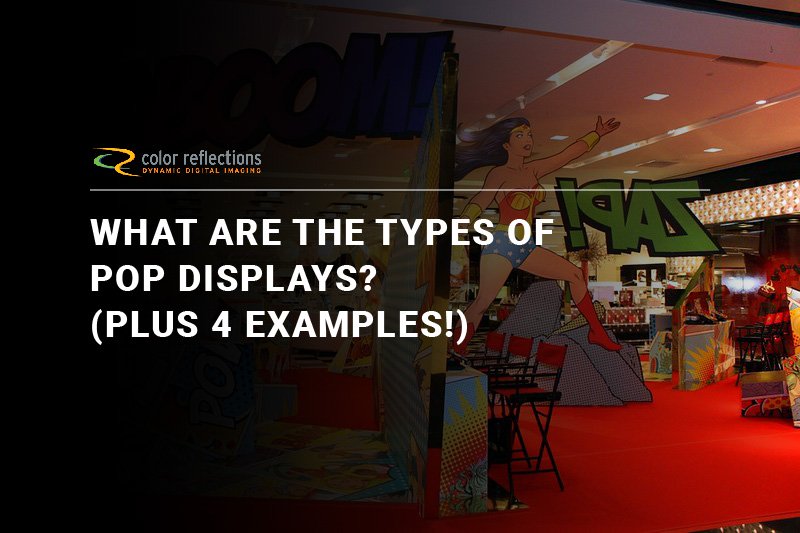With so many consumers using online shopping to make purchases today, brick and mortar stores need all the help they can get to catch their customers’ attention and encourage them to buy their products. Point-of-purchase (POP) displays, like a POP display shelf, are a great way to market your merchandise and give you many different options to choose from to display products. However, there are a variety of POP displays available, so how do you know what would work the best for you? Are there certain types of POP displays that would fit better in your store or office? Read on to learn more about POP displays and how they can help your sales grow.
Want an eye-catching POP display for your store?
Contact Color Reflections can create high quality retail graphics for your business!
Types of Point of Purchase (POP) Displays
Different types of POP displays are built in different ways. To choose the one that will work best for you, some of the things you’ll have to consider include: your budget, how long you need the display in your store, where you plan to use it within your store, and what products you want to have in the display
The three main types of POP displays include: temporary, semi-permanent and permanent.
Temporary Displays
As the name implies, a temporary POP display is created to last for a short amount of time. These displays are usually made from corrugated cardboard and other inexpensive materials and are a cheaper upfront price than other types of displays. While they are built to withstand a busy retail environment, they tend to last only about 3 to 6 months. Some temporary POP displays come with the products already stocked, so the display can be recycled once everything has sold.
Most retailers like to use temporary POP displays for seasonal product promotions or for introducing new products to their customers. With temporary POP displays being more affordable, businesses are able to swap out these short-term displays on a regular basis. This helps them to stay fresh, innovative and creative in the eyes of their clients. Also, if a POP display shelf doesn’t seem to be working, it is easier to bring in a new temporary display in a month or two and try something different for customers.
Semi- Permanent Displays
Constructed from more durable materials than temporary displays, semi-permanent POP displays are designed to last from 6 months to a year. Typical materials used to make semi-permanent solutions include acrylic, glass, heavy-duty cardboard, metal and wood. These items help the POP displays hold up to more customer contact and to being moved around a retail space from time to time.
Also known as secondary displays or off-shelf displays, semi-permanent POP units tend to be used for higher ticket items since they have a higher-quality look. They can be restocked a few times before being recycled or discarded. However, these types of POP displays also have a higher up-front cost, so that needs to be taken into consideration when planning the budget for your store.
Permanent Displays
A permanent POP display, unlike its name, is not really permanent. These types of displays are built to last anywhere from 1 to 3 years. Made from plastic, metal, wood, glass or even heavy-duty cardboard, these display options are typically designed to look like a kiosk or a separate store within a larger store. Permanent POP displays are popular in club stores and are not as common as other types of displays.
Since a permanent display is built from more durable materials, they cost a good bit more than the temporary or semi-permanent units. But, if it is well designed and its use is well planned, a permanent display can often bring a retailer enough sales that the investment is worth it, and the POP display pays for itself.
Examples of Point of Purchase Advertising
Product POP displays can be found in practically every store you visit. These marketing devices are so versatile they can be created for use on floors, shelves, walls and countertops. Since there are several different types of POP displays, there are any number of ways a POP display can be used by businesses to catch their customers’ attention and create sales.
Floor Stands
Floor stands, or floor displays, are the most common type of POP displays used today. Most consumers are familiar with this POP display in retail stores. Typically, they are cardboard displays placed in the aisle of a store, usually near similar items. They contain a new, seasonal, or on sale item stocked and surrounded by graphics, logos and advertising that draw the shopper’s attention. Retailers can use these displays to stop a customer on their stroll down an aisle or pull them from the regular items stocked on the shelves nearby.
For instance, during the holiday season, it is common to see retail shop POP displays of cinnamon, pine or other Christmas-y scented air fresheners displayed in a floor stand near the standard air fresheners. A customer might be looking for an air freshener, planning to buy their usual scent, but when they see the seasonal graphics and holiday colors, they are drawn to the idea of using the product that will make their home smell more like the season. Placing the floor stand in the shopper’s path, close to similar items, will help you generate more sales, as it attracts the consumer’s attention and reminds them of the holiday or a special memory of the season that will encourage them to make a purchase.
Counter Displays
Counter displays are created to fit the most product in the smallest space. These types of POP displays are what customers usually see as they get closer to the cash register in a store. Gum, lip balm, candles, candy, toothbrushes and more can be marketed through counter POP displays. To catch the shopper’s attention as they are ready to leave the store, these displays need to be unique and eye-catching.
Smaller stores, convenience stores, and grab-and-go types of retailers are good places to use counter displays. Unlike larger stores where shoppers plan to spend more time looking at items, these locations need to have products where customers will easily see them and be able to make a purchase without debating between multiple choices. The counter display, if creatively designed, will attract the shopper and encourage them to make more impulse buys.
Shelf Talkers
Shelf talkers, or hangtags, are hanging signs that are attached to a store’s shelf. These POP displays stick out into the customer’s line of sight and use bright colors and graphics that pop to catch their eye as they walk down the aisle. One of the more affordable marketing pieces available to businesses, these displays are typically used to point out something important about an item. The signs might have information that will educate the shopper about the product, point out a sale, or show off a new item.
A good example of a successful shelf talker would be one used to promote a new type of vitamin. The sign could have colorful graphics to attract attention and contain important information on what is new and different about these vitamins. Additionally, the hangtag could have coupons attached to it that a customer could use to get a discount on a bottle of the new vitamins. The shelf talker POP display raises the profile of the vitamins, encourages their sale, and attracts customers back to the store.
Interactive Displays
In this technology-driven day and age, where consumers have gotten used to everything being touchscreen and customizable, interactive displays are becoming more popular with retailers. These types of displays in retail have gotten much more accessible to businesses, since tech such as tablets and laptops have become more affordable. Interactive advertising and marketing have become a fashionable part of creative POP displays in recent years.
Using a touchscreen or interactive aspect in a display can create a more personalized and memorable buying experience for your customers. For instance, if you are in the beauty and skincare market, you might consider a display that helps shoppers choose the right skincare products for their needs. A touchscreen that allows them to answer questions about their own personal skin requirements and then matches them with the right products could be the best way to help increase your sales. It will also aid in giving consumers a memorable shopping trip and encourage them to return to your store in the future.
POP displays remain one of the most popular ways to market products within retail spaces. However, with such a variety of product POP displays that can be created for businesses, retailers need to weigh their options before committing to the type of display that will work best for their customers and their products. Some research and planning will go a long way to ensure that the POP displays you choose for your store will be the right ones to bring you the best sales and return on your investment.

